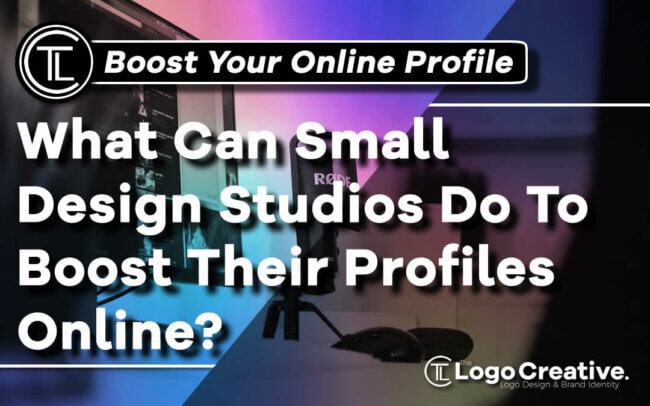Most designers (and design studios, for that matter) build their reputations through networking. To be more specific, they cut their teeth doing work for people they know, or second-hand acquaintances. In this article we answer the question of What Can Small Design Studios Do To Boost Their Profiles Online?
After all, it’s far easier to get the benefit of the doubt from such people — and when you work on a brief for someone in your neck of the woods, they know they can track you down in the event that you fail to meet your end of the bargain.
At some point, though, they need to spread their wings by moving into the online world. In doing so, they can vastly increase their available opportunities, and start to build notable brands that can eventually precede them (making it far easier for them to convert prospective clients).
They can also get better at what they do — change is vital for that, of course. But it’s far from easy to get established online, as many businesses have found over the years.
It isn’t the quality of the work that’s the decider, or how efficiently a design studio runs: it’s how effectively it can make itself a destination supplier, pushing those in need of top-notch designs to get in touch without even being prompted.
The bigger the profile, the easier it is to achieve (and maintain) an impressive level of success.
In this post, then, we’re going to look at some tactics through which small design studios looking to make their names can boost their online profiles.
If you’re running such a studio, consider implementing some or all of them: given the immensity of online business (particularly during a pandemic), it’s inarguably an important area to invest in. Let’s get started.
Table of Contents
Devise Simple and Memorable Brand Elements
Before it makes a concerted effort to be noticed online, a small design studio needs to forge a brand identity that’s fitting, eye-catching, and memorable.
This identity should be mapped out in a comprehensive set of brand guidelines covering everything from how the company name should be written in third-party content to what tone it should take when emailing clients.
You might think that a design studio would know exactly how to get this process right, but that isn’t necessarily the case. The temptation to do more — to really show off their skills — can drive designers to create needlessly-complicated brand elements that are never going to work.
Think about every overdone logo design you’ve ever seen: too many shapes, too many colours, too many stylised elements.
Those who aren’t capable of rationally assessing their own work should forward it to others for feedback — and when it becomes clear that a brand identity has been overengineered, it’s vitally important to rework it before moving on to a full marketing campaign.
Would Nike have reached its current level of popularity and awareness without an elegant tick and the words “Just do it”? It seems fairly implausible.
Those ingredients and the simplicity of the underlying message turned it into a cultural staple that’s rooted in all our minds. And though it is possible to rebrand down the line, it’s a waste of effort.
It’s far better to put the time in early and give your sleek branding elements plenty of time to sink in.
Place Emphasis on Their Areas of Expertise
There are plenty of design studios out there, many of which have glowing track records, lists of high-profile clients, and rock-solid consistency. How can small design studios compete with them? The answer isn’t to cast a wider net: it’s to go further into relevant niches.
A studio that likes to work on 3D animation for instructional videos should focus on that, for example, as it could plausibly compete for that relatively-small piece of the pie against much larger and better-prepared all-rounders. Another way to stand out is to talk about special skills with specific tools (or specific suites of tools).
This is a common move in today’s digital industry. Look at how Aware (an ecommerce developer) targets Magento specifically even though it surely could develop for other platforms like Shopify or WordPress — or how IntY (a cloud solution distributor) shapes its website around Microsoft’s cloud ecosystem, leaning on a long relationship with the Windows developer.
In addition to giving the impression that their businesses are tightly-focused (instead of spreading themselves too thin), small design studies can build their content around essential and hyper-relevant keywords.
When you can’t compete for “design studio”, you might be able to compete for “design agency with blender animation expertise” or something similar.
Develop Attention-Grabbing Business Websites
While it’s true that working on a business website won’t bring more visitors in right away (people need to see a site before they can view it positively, and they won’t see it if they don’t choose to click on it), it will bring in more visitors in the long run. At least, it will if it’s done correctly.
A design studio’s website needs to highlight most (if not all) of its core competencies.
In other words, the business website for a design studio should also be one of its portfolios, if not its only portfolio. It’s a perfect opportunity to showcase design prowess: the layout, the visuals, the animated page transitions… If you can’t design a spectacular website, how can you be trusted to design anything else?
There are two huge ways in which a finely-honed studio website can prove useful here. Firstly, it can impress visitors to the extent that they choose to talk about the company elsewhere in their free time (most likely driving referrals in the end).
Secondly, it can appear as an example in some of the myriad roundup lists that always appear when companies need blog content.
The beauty of the latter point is that the small studios don’t need to just wait and hope that the right people will discover their sites. They can simply forward them to the right people and let them decide.
If they’re not impressed, then no harm done — and if they are and choose to include the sites in their roundups, it’ll mark some excellent free exposure.
Show Strong Personality on Creative Podcasts
The podcasting world has grown immensely in the last decade, and it now feels as though almost everyone has their own podcast — spanning just about every industry you can think of. Design is certainly no exception.
The creative process is endlessly fascinating to those who dedicate their days to it, and there are countless podcasts out there on the topic of design.
Usefully, these podcasts (particularly those running multiple episodes each week) tend to need guests to spice things up and provide some outside perspectives — and all that’s needed to get a good chance of appearing on such a podcast is a simple email or call asking to appear.
The next step is to get the most charismatic and engaging designer to make the appearance.
Why does charisma matter? Because as much as they’ll need to talk about their skills and the prowess of the design studio as a whole, it’ll be even more important that listeners like them.
If people don’t like them, they’ll find reasons to disregard what they have to say. And if they do like them, they’ll treat their statements and anecdotes as beyond contention.
Just one successful guest appearance on a popular podcast can make a huge difference, picking up some social media buzz along with follow-up appearance requests from that podcast and others of a similar nature. And if that specific designer sees their profile grow immensely as a result, they can parlay that into advancement for the entire business.
Offer Expert Guidance Through Social Media
When they’re trying to build up enough renown to be hired for big projects, design studios can prioritise tuition: helping beginner designers with learning the fundamentals, specifically.
They can grow their blogs with in-depth guides, create detailed tutorials for YouTube, or do both. They can then engage with people who need their assistance through social media.
The great (and terrible) thing about social media is that it’s mostly public. Unless you pointedly choose otherwise, the conversations you have with others can be seen by anyone else. This is good for design studios working to help people because it allows their good work to be noticed.
Design experts who notice might be impressed and choose to promote them, while prospective clients might note their mastery of design principles and decide to reach out to them.
Should they wish to, small studios can even create (and sell) full training courses. Making some money on the side through expert teaching can make it abundantly clear that a design studio has what it takes to succeed, and it will certainly help with balancing the budget of a growing business of as-yet-limited online renown.
As noted earlier, getting noticed online is never easy, and in some cases it can take years of grinding to build up a decent reputation. That’s far too long. Small design studios don’t need to take things so slowly, and they don’t even need huge budgets to accelerate the process. Simply taking advantage of the suggestions set out here should suffice.
Join The Logo Community
We hope this article has answered the question of What Can Small Design Studios Do To Boost Their Profiles Online?
If you would like more personal tips, advice, insights, and access to our community threads and other goodies, join me in our community.
You can comment directly on posts, access our community threads, have a discussion and ask questions with our founder Andrew.
If you’re looking to learn more about brand strategy, we highly recommend eRESONAID with our friend and acclaimed brand strategist and author Fabian Geyrhalter, it’s packed full of knowledge and insights you will need to learn to become a brand strategist or apply what you learn within your own business.
 Author Bio
Author Bio
Rodney Laws is an ecommerce platform specialist & online business consultant. Worked in the eCommerce industry for two decades, helping brands achieve their goals. Get his advice by visiting EcommercePlatforms.io and reading his detailed reviews.


